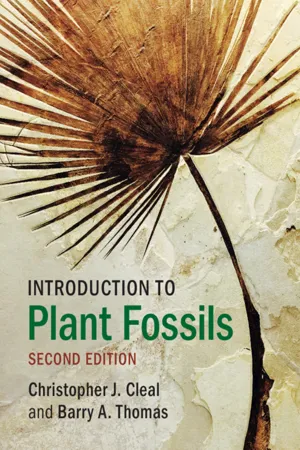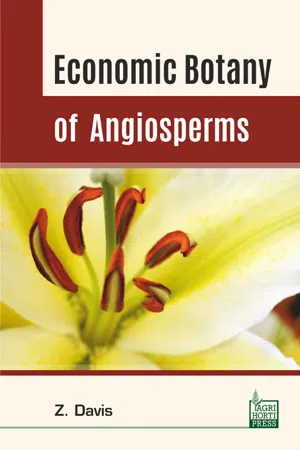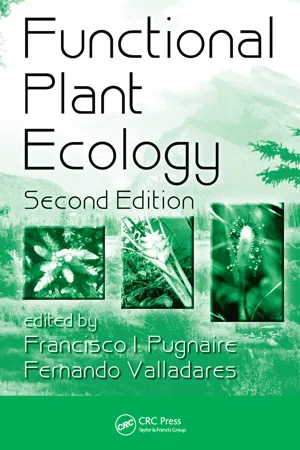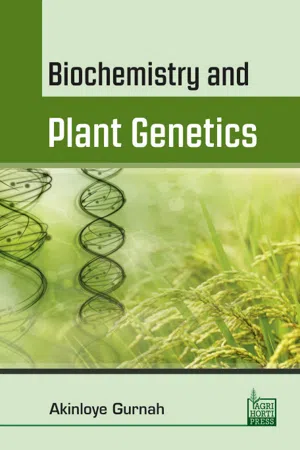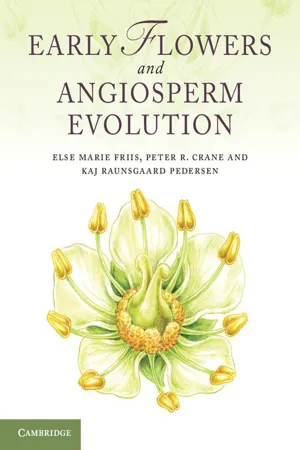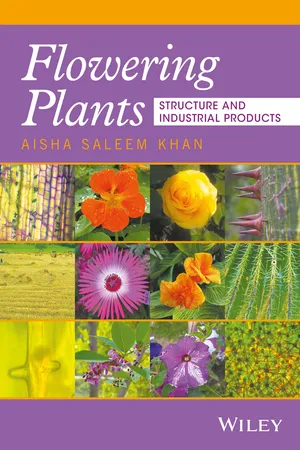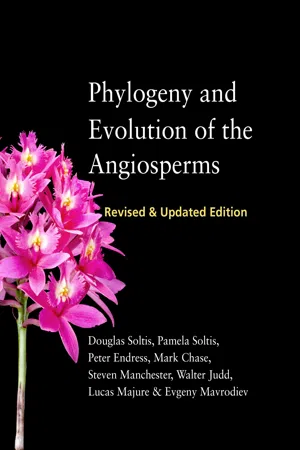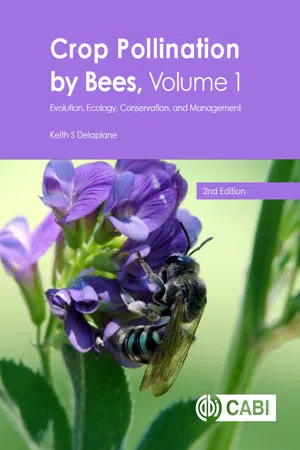Biological Sciences
Angiosperms
Angiosperms are flowering plants that produce seeds enclosed within a fruit. They are the most diverse group of land plants and play a crucial role in ecosystems as food sources for animals and humans. Angiosperms have specialized reproductive structures, such as flowers, which have contributed to their evolutionary success and widespread distribution.
Written by Perlego with AI-assistance
Related key terms
1 of 5
9 Key excerpts on "Angiosperms"
- eBook - PDF
- Christopher J. Cleal, Barry A. Thomas(Authors)
- 2019(Publication Date)
- Cambridge University Press(Publisher)
Chapter 10 Angiosperms Flowering plants, or Angiosperms as they are more properly called, have dominated most ter- restrial ecosystems of the world for the last 100 million years. There are nearly a quarter of a million living species in a bewildering variety of forms (Fig. 10.1) that have been grouped into between 300 and 400 families. Angiosperms range from very small floating plants such as Lemna to enormous, long-lived trees: they show a greater range of growth habits and morpho- logical variation, and live in a greater range of environments than any other group of living vas- cular plants. Flowering plants form the basic diet of most herbivorous animals and we rely on them for agriculture, horticulture, many pharmaceut- ical products, fuel and building materials. Their importance to us has inevitably caused much interest in the origins and early evolution of Angiosperms, and there has been considerable work done on their fossil history. What makes an angiosperm? It is difficult to define what actually an angiosperm is, especially if we are looking at plant fossils. The commonly held concept of a plant with showy and obvious flowers is not tenable for many angio- sperms, and the range of characters recognised in living Angiosperms is huge in such an enormous group with so much plasticity of form. Neverthe- less, there are some features that together can be taken to prove angiosperm affinity. Presence of a flower. Enclosed ovules or seeds. A double protective layer made up of integu- ments surrounding the embryo sac. Wood with vessels. Development of the food-conducting phloem. Multi-layered pollen walls consisting of pillar- like structures called collumellae, support- ing an outer covering called the tectum. Reticulate venation pattern in the leaves. The distinctive double fertilisation mechan- ism where two male nuclei fuse with nuclei in the female egg cell. A pollen tube grows through the micropyle, enters the ovule and releases two sperm cells. - eBook - PDF
- Davis, Z(Authors)
- 2018(Publication Date)
- Agri Horti Press(Publisher)
It is believed that insects fed on the pollen, and plants thus evolved to use insects to actively carry pollen from one plant to the next. Seed producing plants, which include the Angiosperms and the gymnosperms, have heteromorphic alternation of generations with large sporophytes containing much reduced This ebook is exclusively for this university only. Cannot be resold/distributed. Basic Classification of Flowers 39 gametophytes. Angiosperms have distinctive reproductive organs called flowers, with carpels, and the female gametophyte is greatly reduced to a female embryo sac, with as few as eight cells. The male gametophyte consists of the pollen grains. The sperm of seed plants are non-motile, except for two older groups of plants, the Cycadophyta and the Ginkgophyta, which have flagellated sperm. Flowering Plants Flowering plants are the dominant plant form on land and they reproduce by sexual and asexual means. Often their most distinguishing feature is their reproductive organs, commonly called flowers. Sexual reproduction in flowering plants involves the production of male and female gametes, the transfer of the male gametes to the female ovules in a process called pollination. After pollination occurs, fertilization happens and the ovules grow into seeds within a fruit. After the seeds are ready for dispersal, the fruit ripens and by various means the seeds are freed from the fruit and after varying amounts of time and under specific conditions the seeds germinate and grow into the next generation. The anther produces male gametophytes, the sperm is produced in pollen grains, which attach to the stigma on top of a carpel, in which the female gametophytes (inside ovules) are located. After the pollen tube grows through the carpel’s style, the sex cell nuclei from the pollen grain migrate into the ovule to fertilize the egg cell and endosperm nuclei within the female gametophyte in a process termed double fertilization. - eBook - PDF
- Francisco Pugnaire, Fernando Valladares, Francisco Pugnaire, Fernando Valladares(Authors)
- 2007(Publication Date)
- CRC Press(Publisher)
The major speciation has indeed occurred in the Angiosperms, a group represented by over 220,000 species (Cronquist 1981). Such species richness is due to different factors (see Section ‘‘Diversification of Angio-sperms’’), of which perhaps the most important is the wider range of growth forms that allow them to inhabit a wider range of habitats than either pteridophytes or gymnosperms. The latter are mostly trees, which restrict the number of habitats where they can live, have limited breeding systems, limited pollination systems, and unspecialized seed dispersal (Givnish 1980). The development of a gynoecium (pistil) in the Angiosperms (term meaning enclosed seeds) has probably been one of the most important steps in the evolution of plants. Seed plants have a wide array of reproductive options that have evolved under particular environmental conditions (e.g., scarcity or absence of pollinators) and that are maintained or changed through the process of natural selection. Next, we focus on such reproductive options, on the factors that select for them and, briefly, on the genetic consequences for the plant population. FIGURE 17.1 The lizard Podarcis lilfordi pollinating the gymnosperm Ephedra fragilis on Dragonera Island (Balearic Archipelago). (Photo by Javier Rodrı ´guez-Pe ´rez. With permission.) Ecology of Plant Reproduction: Mating Systems and Pollination 519 SELF-POLLINATION Most Angiosperms bear perfect flowers (containing both anthers and stigmas) and a large fraction of them are self-compatible and thus potentially selfing species (Bertin and Newman 1993, Vogler and Kalisz 2001). Estimates suggest that 62%–84% of temperate plants (mostly herbs) and 35%–78% of tropical plants (including shrubs, trees, vines, and herbs) are at least partially selfers (e.g., Arroyo and Uslar 1993). Comprehensive reviews of self-fertilization can be found in Jarne and Charlesworth (1993), Holsinger (1996), and Goodwillie et al. - eBook - PDF
- Gurnah, Akinloye(Authors)
- 2018(Publication Date)
- Agri Horti Press(Publisher)
24 Biochemistry of Plant Genetics 2 Flowering Plants Flowering plants (Angiospermae) represent one of the largest groups of primary producers. Their contribution to the production of oxygen as well as that to the nutriment of animals and man is consequently very large. Typically, flowering plants are organized into an underground root and a shoot above ground that consists itself of a stem and leaves. The organs of a plant that serve sexual reproduction are the flowers. Part of the pollinated flower ripens and becomes the fruit. In contrast to many other plant groups, flowering plants are striking, numerous and common. They are the most important group of the so- called primary producers that generate the prerequisite for life on earth: oxygen. Green plants have the ability to convert solar energy into chemical energy (photosynthesis) producing the oxygen necessary for all other organisms as a by-product. The useable plants among the flowering plants are - directly or indirectly - the basis of human existence; they are, too, an important economical factor. A basic knowledge of flowering plants should therefore be among everybody's general knowledge. Much has been written about flowering plants and every reader of this chapter will miss something that he regards worth knowing, while he might find other information trivial. But everybody will understand that it is impossible to review in a few lines a theme about which an extensive, partly popular scientific literature exists. And although this term may sometimes be used in a disparaging way, most of the popular scientific literature is scientifically correct, lucid and, above all, very well illustrated. To get an idea of the variety of existing plants and to get to know special species, it is necessary to identify them. Many books on classification with different approaches exist. In many popular books, colour photos or drawings are used and often is the colour of the flower a primary feature of recognition. - eBook - PDF
- Else Marie Friis, Peter R. Crane, Kaj Raunsgaard Pedersen(Authors)
- 2011(Publication Date)
- Cambridge University Press(Publisher)
14 Introduction to Angiosperms The ovary may have a single cavity (locule) that contains the ovule, but frequently it is divided by partitions (septae) into several locules (Figure 1.16). The ovules are borne on one or more placentae within the locule or locules, and where there are many ovules the placentae may be linear or diffuse. The most common ovule type in Angiosperms, including among the earliest diverging extant lineages, is anatropous and bitegmic (Figure 1.17). This is most likely the basic condition for Angiosperms as a whole. The nucellus is gener- ally prominent and well developed (crassinucellar). In a few Angiosperms, the ovules are orthotropous (Figure 1.17). The number of integuments may also be reduced to one, or rarely three integuments may be present. The nucellus may also be poorly developed (tenuinucellar). In most non-angiospermous seed plants ovules are ortho- tropous, but recurved ovules, similar to the anatropous condition, also occur in some conifers. Most non-angiosperm seed plants have a single integument, but in Gnetales and some conifers there are additional envelopes surrounding the nucellus. Studies of ovule development show that the additional envelopes of Gnetales do not develop in the same way as the angiosperm integument (Endress, 1996a), but the homologies of these additional envelopes with structures in Angiosperms remain uncertain. Pollination. Insects and a variety of other animals play an important role in pollen transfer in Angiosperms, and it is generally believed that the bisexual angiosperm flower, as well as the enormous floral diversity exhibited by the group, is intimately linked to co-evolutionary interactions between Angiosperms and their pollinators. Insect pollin- ation does occur in other seed plants, but it is only in Angiosperms that it is exploited so consistently, and in conjunction with such diverse and elaborate modifications of the reproductive structures (Chapter 17). - eBook - ePub
Flowering Plants
Structure and Industrial Products
- Aisha S. Khan(Author)
- 2017(Publication Date)
- Wiley(Publisher)
1 An Introduction to Flowering Plants : Monocots and EudicotsThere is no doubt about it that plants are main producers of ecosystem and important in every aspect of our daily lives. Many products which are used in food, nutraceutical, pharmaceutical, textile, cosmetics, perfumery, coffee, tea and beverage industries are in fact derived from plants. They are biosynthesized in different parts of plants and are known as natural products or secondary metabolites. Many of these compounds are defensive in nature which are produced during primary metabolic activities in plants. Many pigments in flowering plants are also secondary metabolites which are crucial for their pollination. Secondary metabolites include alkaloids, flavonoids, betalains, glycosides, tannins, terpenoids and saponins. They will be introduced in the next chapter.This book deals with flowering plants, that is, Angiosperms as they make one of the abundant group of plants of economic importance. However, before discussing major products of Angiosperms, their biosynthesis and applications, it is important to discuss what are Angiosperms? How did they evolve? What is their body organization and what kind of cells they have? So in the next section, a brief introduction of Angiosperms and their classification is discussed.1.1 An Introduction to Major Group of Angiosperms: Monocots, Eudicots and Basal Angiosperms
All plants are considered to be a group of related organisms which are capable to synthesize their own sugars during photosynthesis, possess the cell wall, and generally with the differentiation of their bodies in roots, stems, leaves, flowers or flower‐ like structures. But recent trends in molecular phylogenetics have shown that they are not as much closely related as thought before. In fact, plants can be best described as ‘a group of different organisms which evolved independently during course of evolution and share similar characteristics like ability to synthesize their own food within their chloroplasts, have chlorophyll a as a necessary photosynthetic pigment and possess the cell wall which largely comprises of cellulose'. Their body is differentiated in vegetative and reproductive organs (spore or seed‐producing structures) and are therefore classified in one kingdom plantae. Division within kingdom plantae is based either on the presence or absence of vascular tissues (xylem and phloem) or spore‐producing structures. Bryophytes like liverworts, hornworts and mosses are non‐vascular spore producing plants while pteridophytes are vascular plants which produce spore, for example, ferns, horsetails and clubmossses. Other two major groups are seed‐producing plants, that is, gymnosperms which produce seeds which are not enclosed within their ovaries, and Angiosperms - eBook - ePub
Phylogeny and Evolution of the Angiosperms
Revised and Updated Edition
- Douglas Soltis, Pamela Soltis, Peter Endress, Mark W. Chase, Steven Manchester, Walter Judd, Lucas Majure, Evgeny Mavrodiev(Authors)
- 2018(Publication Date)
- University of Chicago Press(Publisher)
Relationships among the lineages of extant seed plants, as well as the relationships of living groups to fossil lineages, have been issues of longstanding interest and debate. A topic of particular intrigue has been the closest relatives of the Angiosperms. Angiosperms are responsible either directly or indirectly for the majority of human food and account for a huge proportion of photosynthesis and carbon sequestration. They have diversified to include 350,000–400,000 species in perhaps 130–170 myr and now occur in nearly all habitable terrestrial environments and many aquatic habitats. Understanding how Angiosperms accomplished this is of fundamental evolutionary and ecological importance.At some point, nearly every living and fossil group of gymnosperms has been proposed as a possible ancestor of the Angiosperms (e.g., Wieland 1918; Thomas 1934, 1936; Melville 1962, 1969; Stebbins 1974; Meeuse 1975; Long 1977; Doyle 1978, 1998a,b; Retallack and Dilcher 1981; Crane 1985; Cronquist 1988; Crane et al. 1995; reviewed in Doyle 2006, 2008, 2012; Friis et al. 2011). Among extant seed plants, the relationship between Angiosperms and Gnetales has received considerable attention.Ascertaining the closest relatives of the Angiosperms is not only of great systematic importance but also critical for assessing character evolution. For example, the outcome of investigations of character evolution among basal Angiosperms, including studies focused on the origin and diversification of crucial angiosperm structures (e.g., floral organs, endosperm, vessel elements), may be influenced by those taxa considered their closest relatives. The effect of outgroup choice on the reconstruction of character evolution within Angiosperms is readily seen via the widespread use of Gnetales as an outgroup for Angiosperms. As reviewed below, for nearly two decades beginning in the 1980s, Gnetales were considered by many to represent the closest living relatives of the Angiosperms. The use of Gnetales as an angiosperm outgroup profoundly influenced character-state reconstruction within the flowering plants (see “The Anthophyte Hypothesis” section). - Barbara A. Ambrose, Michael D. Purugganan, Barbara A. Ambrose, Michael D. Purugganan(Authors)
- 2012(Publication Date)
- Wiley-Blackwell(Publisher)
Chapter 6 IDENTIFYING KEY FEATURES IN THE ORIGIN AND EARLY DIVERSIFICATION OF Angiosperms Paula J. Rudall Royal Botanic Gardens, Kew, Richmond, Surrey, UKAbstract: Understanding the origin and early diversification of the flowering plants (Angiosperms) represent primary goals in biology. However, despite extensive knowledge of angiosperm biology and biodiversity, much remains to be determined about their evolutionary origin, partly because many of their characteristic (some supposedly diagnostic) features probably evolved iteratively among seed plants. This chapter focuses on the early evolutionary history of the “key” angiosperm reproductive structures: carpels, flowers, and inflorescences. It discusses some of the major morphogenetic markers that circumscribe deep nodes within the Angiosperms, notably the base of the eudicot clade. Despite recent advances in comparative genomics and developmental genetics of an increasing range of model organisms, satisfactory resolution of longstanding and fundamental questions regarding angiosperm origins remain hampered by the problematic phylogenetic framework for seed plants, which is notable for strongly contrasting hypotheses based on molecular versus morphological data. Ongoing integrated comparative studies can potentially clarify floral evolution within Angiosperms.Keywords: angiosperm; canalization; carpel; development; evolution; flower; inflorescence.6.1 Introduction: key features of flowering plantsToday, the flowering plants (Angiosperms) represent by far the most species-rich group of land plants, dominating floras and habitats throughout most of the world. They are the primary food source for most land animals, including humans. Several potentially key features are widely hypothesized to characterize the Angiosperms, including flowers, carpels, columellate pollen, non-motile sperm, elongated pollen tubes with callose plugs, double fertilization leading to endosperm production, highly reduced megagametophytes and microgametophytes, an outer integument enclosing the ovule, paracytic stomata, and vessels in the secondary xylem (e.g., Doyle & Donoghue 1986; Williams & Friedman 2004; Rudall 2006; Rudall & Bateman 2007; Williams 2008; Doyle 2009). However, despite extensive knowledge of angiosperm biology and biodiversity, we remain unclear about precisely how to circumscribe the Angiosperms (and hence even more perplexed about non-angiospermous seed plants, the gymnosperms), because many of these important angiospermous features are either difficult to interpret, absent from some early-divergent Angiosperms, or probably evolved more than once among seed plants.- eBook - ePub
Crop Pollination by Bees, Volume 1
Evolution, Ecology, Conservation, and Management
- Keith S Delaplane(Author)
- 2021(Publication Date)
- CAB International(Publisher)
1 Angiosperms and Bees: The Evolutionary Bases of Crop PollinationThis volume is about one of the most celebrated relationships between species in all of natural history – that relationship between the bees and the flowering plants, the Angiosperms. To be precise, this volume explores the relationship between bees and those Angiosperms that make up modern crop plants that depend on bee pollination.1.1. Sex: Diversity with StabilityFor the plants, it is all about sex – that most extravagantly successful (and arguably popular) invention of natural selection that set multicellular organisms on their path toward global dominance. ‘Global dominance?’ you ask, ‘How’s that?’ That’s a fair question when one considers the other successful life alternatives.The single-celled life alternative is indeed amply represented in Earth’s biota. Just consider the bacteria and archaebacteria that carpet the planet, colonizing virtually every terrestrial and aquatic niche, even penetrating kilometres deep into the planet’s crust. It is these simplest representatives of the biological continuum that baffle us with their boundary bending tolerances to environmental extremes (Merino et al., 2019), making them figure prominently in our discussions about the evolution of life on other planets (Sundarasami et al., 2019).At the opposite pole of biological organization we have those assemblies of multicellular organisms who have banded together so tightly that we have to consider the group, not the individuals who make it up, as a Darwinian unit of selection. These we call the superorganisms (Wilson and Hölldobler, 2009 ), most famously represented by the termites, ants, and the social wasps and bees (most wasps and bees are not social), although quirky representatives exist in the forms of a genus of shrimps (Synalpheus spp.) and the naked mole rats of Africa (Heterocephalidae). The ecological impact of the superorganisms is wildly out of proportion to their species count. As one example, the ants and termites make up only 2% of the estimated 900,000 known species of insects on Earth, yet together account for more than half of total insect biomass (Wilson and Kinne, 1990
Index pages curate the most relevant extracts from our library of academic textbooks. They’ve been created using an in-house natural language model (NLM), each adding context and meaning to key research topics.
